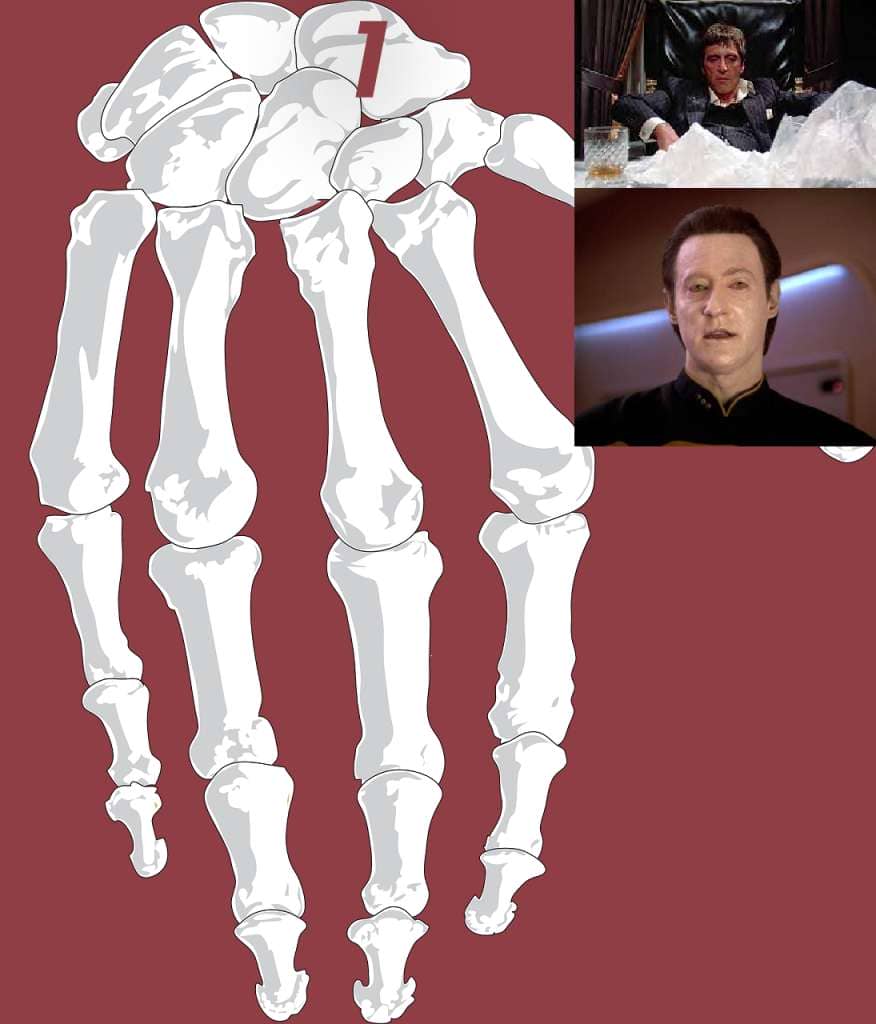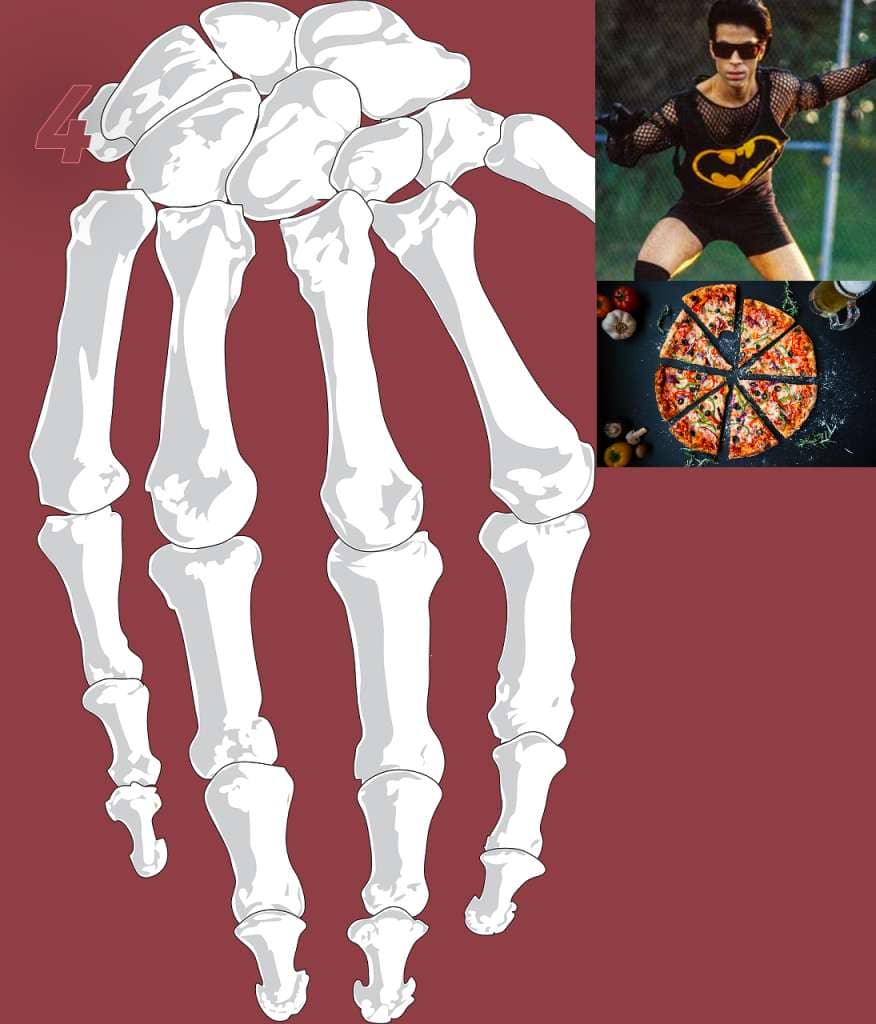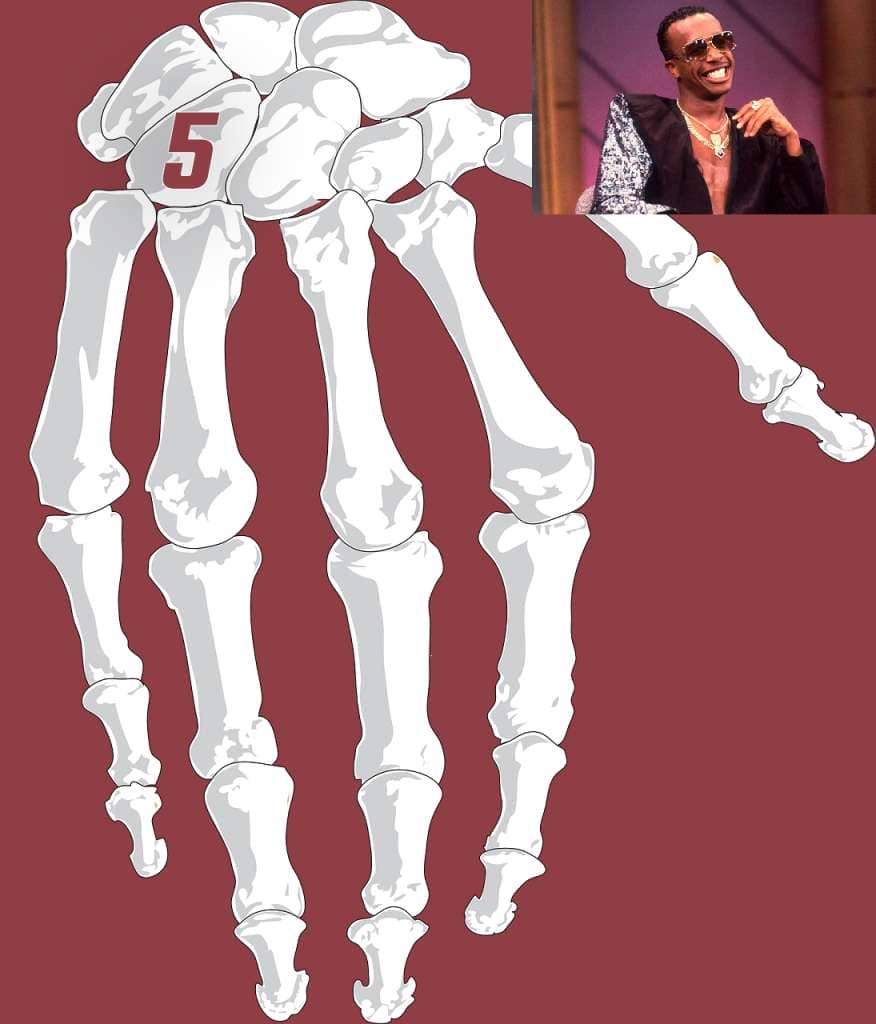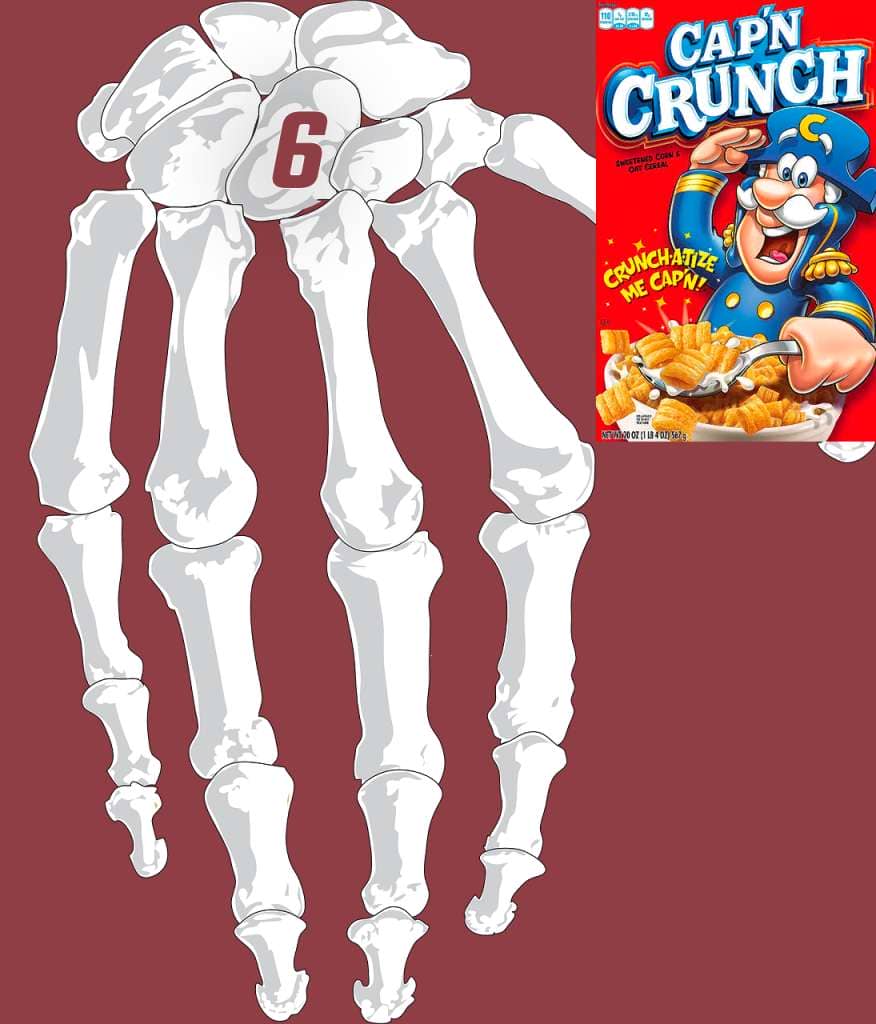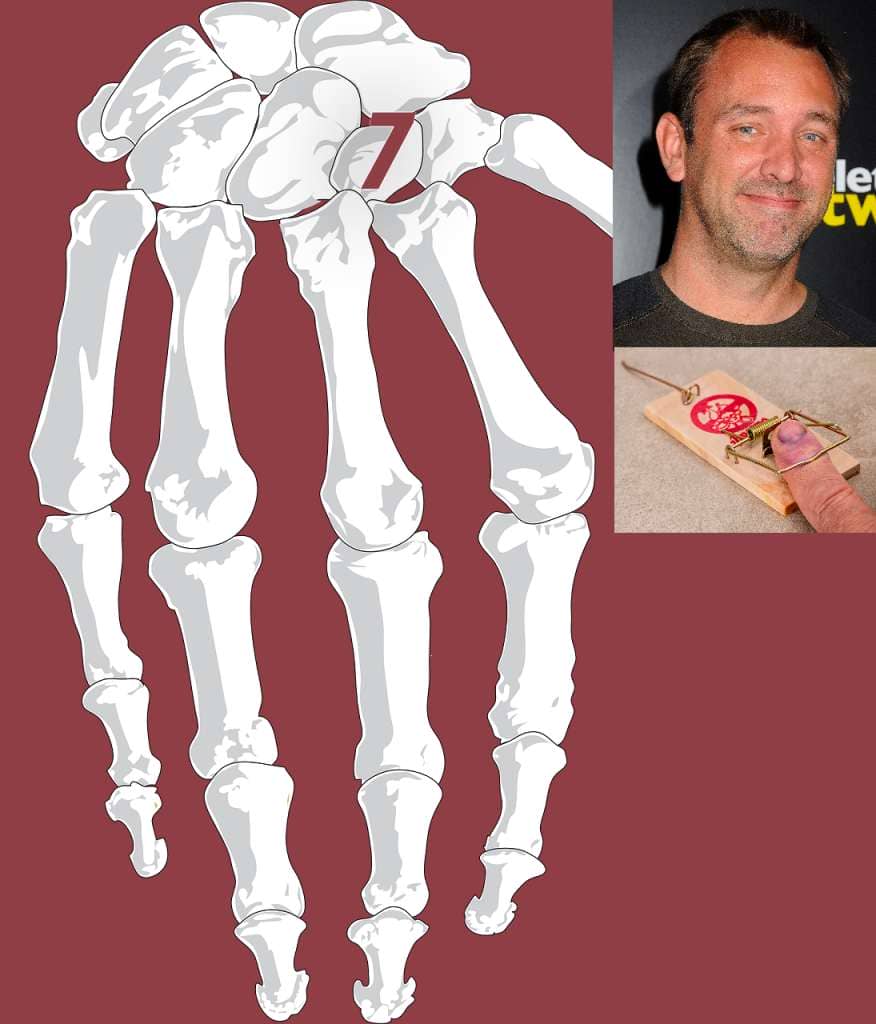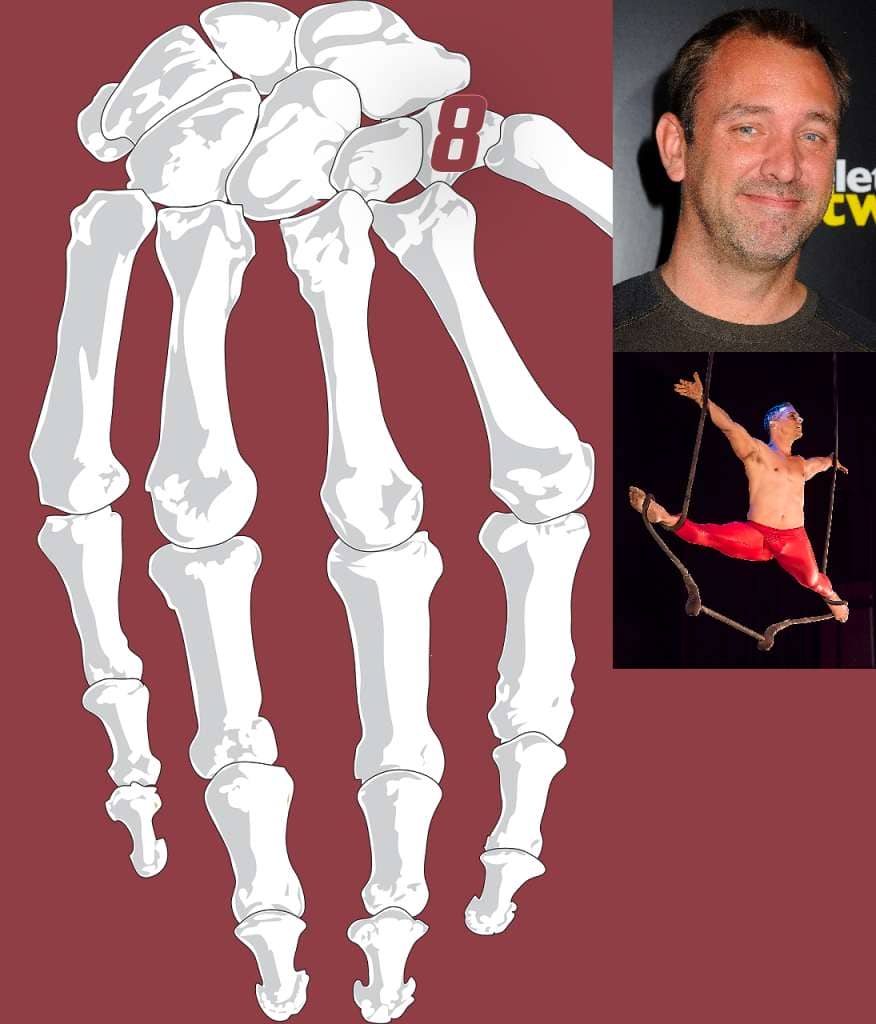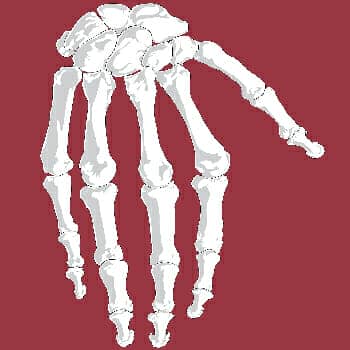 A good mnemonic for the carpal bones is hard to find.
A good mnemonic for the carpal bones is hard to find.
They’re often far too abstract.
You’re in a hurry, after all. You need to learn the bones of the hand quickly and move on to other things.
Stick around.
On this page, I’m going to share powerful mnemonics for the bones of the hand that are probably more powerful than any others seen before.
I can make that claim because what you’re going to learn today is based on the best contemporary memory science, thousands of years of mnemonic tradition and everything I’ve learned from the memory competitors over the past three decades.
Best part?
You’ll be able to use the unique medical mnemonics strategy on this page to help you rapidly remember many other aspects of anatomy too.
Ready?
Let’s dive in!
Which Bones Make Up The Hand?
The human hand has 27 bones in total. Together, the bones of the hand are considered part of the arm, and are typically divided into 3 groups:
- 8 carpal bones make up the wrist, or carpus
- 5 metacarpal bones
- 14 phalangeal bones
The 8 carpal bones are themselves divided into two rows.
The Proximal Row
Proximal means “nearer,” so in this case, you can think of the four bones in the proximal row as the closet to your forearm.
Starting from your thumb and moving toward your pinky, these four carpal bones are called:
- Scaphoid (or navicular)
- Lunate
- Triangular (or triquetrium)
- Pisiform
The Distal Row
Distal means further away, so these four carpal bones are in front of the proximal row. They are called:
- Hamate
- Capitate
- Trapezoid
- Trapezium
Now that you know the names of these bones, let’s get into some powerful mnemonics for each of the carpal bones.
How to Remember Carpal Bones
The simplest way to make better associations than you see in other places is to use specific mnemonic images.
For example, the typical mnemonic example you’ll see for all the bones is usually an acronym: Sue Likes Terry’s Pens – Her Cap’s Too Tight.
Sure, some people can get away with borrowing mnemonic devices like this from others. But the majority of us need to use the rules of personalization indicated by active recall research.
The mnemonic examples I’m about to share are based on how I use something called the pegword method.
Let’s have a look at each, and if any of my associations work for you, feel free to use them. But in each case, you’ll get more power by thinking of what you would use based on this simple principle:
Drawing upon associations that are already in your memory makes the information much easier to elaborate, making each carpal bone name much “stickier.”
8 Mnemonics To Memorize The Carpal Bones
As we go through this list of mnemonic examples, keep in mind that my “psychological laundry” might not be right for you.
If you don’t resonate with my “mental lego,” try to understand the logic behind why these alphabetical associations are structured in this way. That way, you’ll be able to model the process for yourself.
One: Scarface Navigates Circles Around The Android Scaphoid
For scaphoid, imagine Scarface and the “android” Data from Star Trek: The Next Generation dancing near your thumb.
You could even imagine them dancing to “ska” music to give the mnemonic more power.
Don’t fret if you don’t know these movie characters. Chances are you know Scarlett Johansson.
The point is to avoid abstract associations that your mind will quickly forget. If you’re going to have an abstraction, make it only part of your mnemonic image.
For example, having Scarlett Johansson climbing a scaffold will help get the “phoid” sound in the word scaphoid.
Now, in this case, there’s also the alternative term “navicular.”
To memorize this, I added the idea to my central image that Scarface and the android are navigating their way to see Scarlett Johansson at a nuclear plant.
That way, all the sounds are represented by famous characters and celebrities.
Two: Lunatics Sing Waterloo for Lunate
Abba is a famous band and one of their most famous songs is called “Waterloo.”
That’s great because the second carpal bone is the lunate and it’s easy to imagine these musicians acting like lunatics.
In fact, using the link and story method in combination with the method of loci, you can turn your wrist into a Memory Palace.
Following the situation with the scaphoid bone discussed above, just add lunatics playing Waterloo and have them going crazy because of something they ate.
Lunatic + ate = lunate.
Three: Thor’s Triumphant Triangle
Although you can readily just imagine a simple triangle for the triangular bone, that’s not exactly the path to power.
As I teach in the Magnetic Memory Method Masterclass, we want to take every chance we have to practice using well-formed mnemonics.
That’s why I chose to use Thor for this carpal bone. His name starts with T and his cape makes him look triangular.
Even better, you can imagine him “trying” to lift his hammer from the surface of this bone but needing to “quit.” Those sounds make it easy to remember the alternative name for this bone: triquetrium.
Four: Prince Eats Pizza At The Farm
The pisiform bone starts with P, and that instantly makes me think of Prince.
There’s an iconic photo of him wearing a Batman shirt while rollerskating. Imagine him rollerskating on pizza while at a form.
Weird image, right? And highly memorable.
I think of him doing this while also trying to hold a Qigong form to give the word pisiform that extra bit of memorability.
Five: MC Hammer Ate The Meat Off The Bone
MC Hammer must have eaten something nasty because on this part of your hand, he’s hammering away like mad.
This might not be the right mnemonic for you, but it gives you a solid example.
Note that at this point, we’ve moved from the distal row to the proximal row and are moving back in the direction we came from.
When it comes to how to remember carpal bones, there’s not necessarily a mnemonic for directionality.
But to make this fact more memorable, try using touch as a kind of journey method. Literally tap or touch the relevant part of your hand as you use spaced repetition to lock these associations into long-term memory.
Six: Captain Crunch Decapitates Himself
Okay, that’s a brutal image. But that’s what makes it so memorable.
You could use Captain Jack Sparrow as an alternative.
At this point, it’s useful to note why some of these bones have their names. For example, caput means “head” in Latin.
This bone is always said to look a bit like a head. The –ate ending is often used in Latin for nouns.
Here’s a video with more details on how to memorize prefixes and suffixes, which is a useful skill to have along with memorizing vocabulary at large:
Seven: Trey Parker Trapped While Searching For His Android
This is another “t” word, but instead of using Thor again, let’s switch things up.
Trey Parker would probably never get caught in a mouse trap. But let’s say that he’s looking for his Android phone and his finger gets caught trying to rescue it from a trap.
Imagining this scene happening on your hand makes the name of this bone very memorable.
Eight: Trey Trapped At The Gymnasium
Since we’ve got Trey reading to go, the last bone is easy to memorize by imagining him fleeing from the trap heading to the gym.
As soon as he gets there, he grabs a trapeze bar and swings way.
And like you, he’s happy that he now knows all of these important bones. Even better, you have a strategy that you can reproduce to memorize all medical terminology.
The Bones Of The Hand Are Just The Beginning
Truly, if you take the principles you’ve just discovered, you can memorize anything you wish. Whether it’s related to anatomy or pharmacology, insulin types or the postural drainage positions, you’re ready to go.
There’s literally nothing proper mnemonics can’t help. So if you’re like more, please grab my free course here:
It will take your understanding of how to learn and remember faster even deeper than we’ve discussed today.
The best part is that there are other ways to use your hands mnemonically. Hand mnemonics have been used to remember parts of the calendar, for example.
But for now, what do you say?
Are you ready to spend just a few minutes to memorize all 8 carpal bones?
Make it happen!
Related Posts
- Mnemonic for Tarsals: How to Remember the Tarsal Bones Quickly
The best mnemonic for the tarsals bones includes their names and locations. Learn exactly how…
- How to Remember Insulins: 4 Fun And Easy Mnemonic Examples
Learning how to remember insulins of each type, including onset, peak times and duration is…
- The Best Glasgow Coma Scale Mnemonics to Help You Remember
You want the best Glasgow Coma Scale Mnemonics and I've got them. Discover how to…

